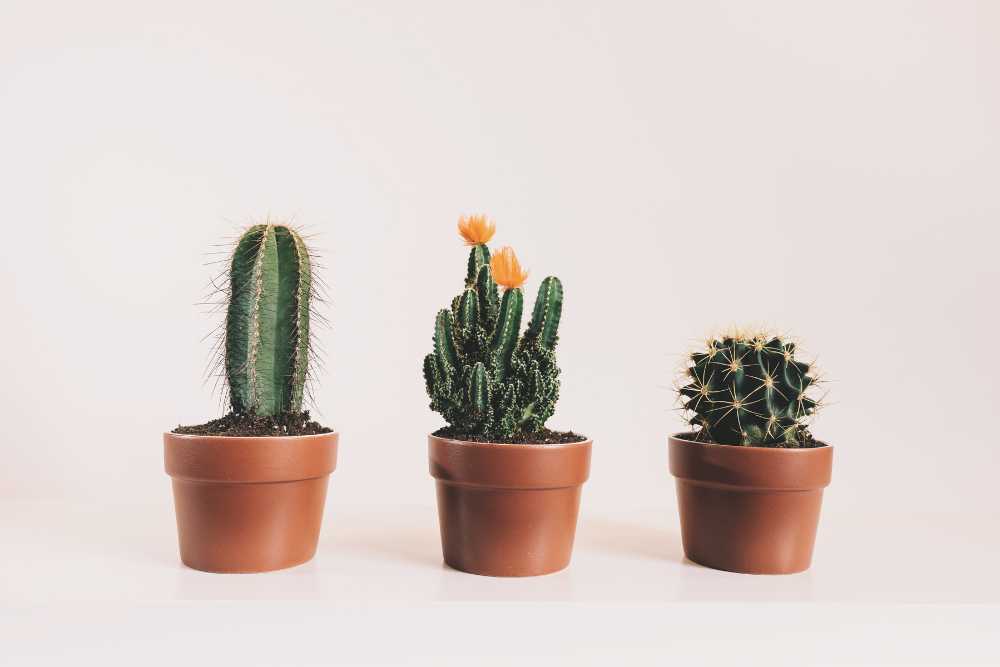17 Best Cactus for Indoors and How to Care for Them
Cacti and succulents are fantastic choices for indoor plants or to compliment a desert-inspired home design theme. The majority of cacti are low maintenance and don’t perform well in cold areas, so they can live in your home just as comfortably as you can. These are low-maintenance succulents, which makes them ideal for someone who frequently forgets to water them. If you want to bring a little bit of nature inside, a cactus plant can be the ideal choice. Let’s have a look at some of the best cactus for indoors.
1. Bunny Ear Cactus / Angel wings
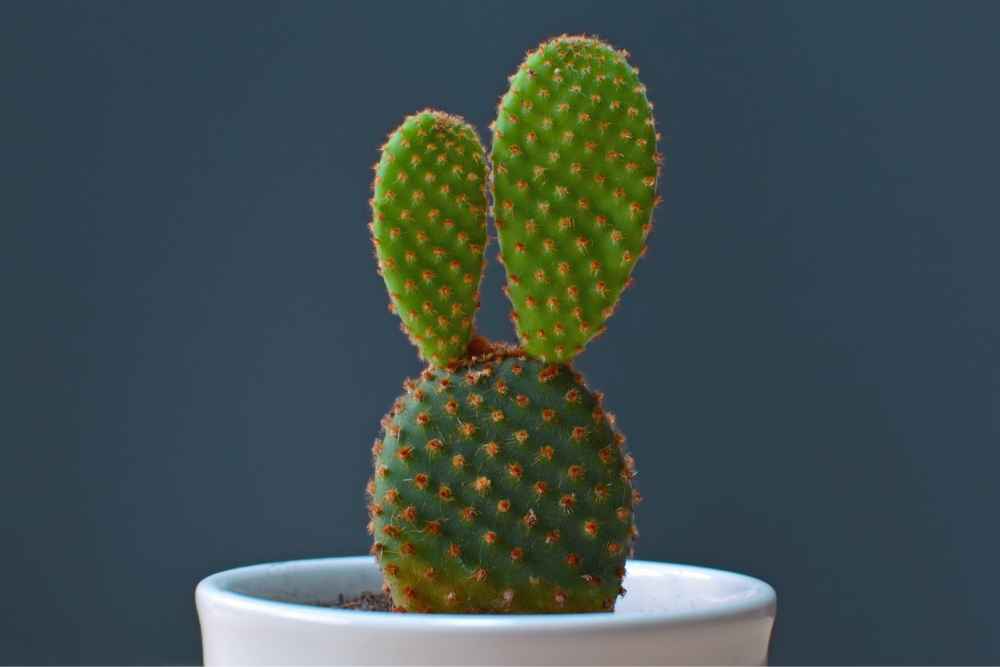
Bunny Ear Cactus (Opuntia microdasys) is an adorable indoor cactus that does have spines. Other common names for the bunny ears cactus include angel wings cactus and polka dot cactus. It is related to the prickly pear cactus of the Southwest. The plant is indigenous to Mexico and South America, where it thrives in arid to semi-arid conditions.
It has a distinctive appearance like bunny ears, and growing them indoors is easy. As a result, it requires a dry, low-humidity environment with a sunny location. But, keep in mind that it can grow up to three feet tall and requires trimming to stay tiny. It is also a slow-growing desert shrub that lacks spines in favor of glochids with white, brown, or black flowers.
The bunny ears cactus is a well-liked houseplant although it doesn’t bloom frequently. As they bloom, the flowers appear on top of the stems and are a cheery yellow color. The Latin word for this cactus, microdasys, means “small, hairy,” just like rabbit ears. The bunny ears cactus should be planted in a mix of loose soil and sand so that it may hold some water while letting the rest drain.
Never let the soil become moist; keep it slightly damp. You should water your bunny ears cactus twice a month throughout the summer (when the water evaporates more quickly). You can avoid watering it more than once a month during the cooler months. It grows best in full, and direct sunlight.
2. Moon Cactus
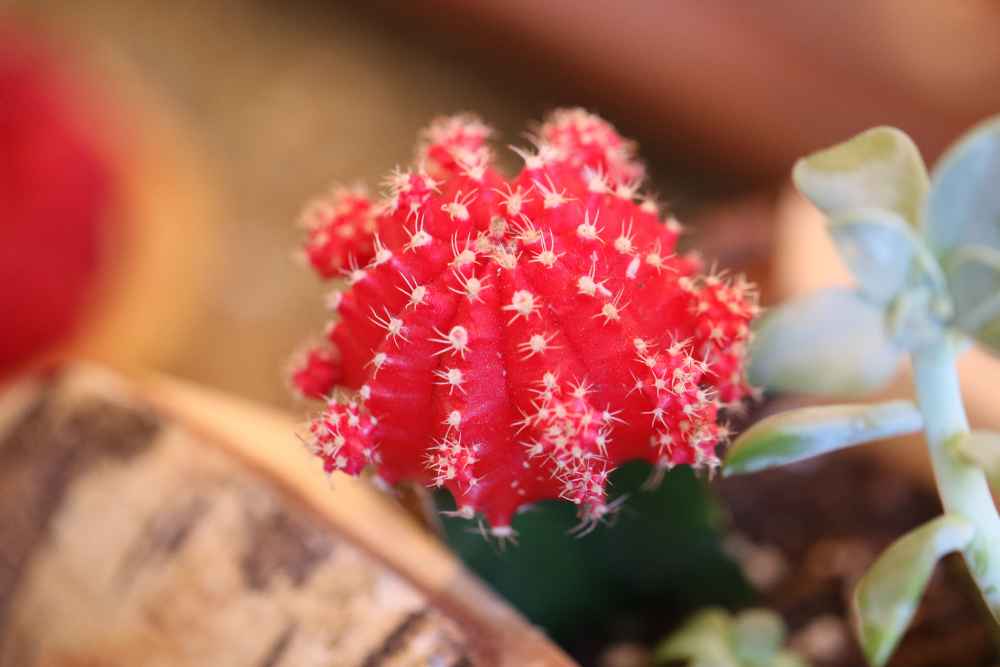
The moon cactus’ scientific name is Gymnocalycium mihanovichii. The species is native to Argentina and Paraguay. South America is where you can find them as well. Ruby Ball, Red Hibotan, Hibotan cacti, and Red Hibotan are all names for Moon Cacti.
The moon cactus is a well-known indoor cactus. Cactus plants come in a variety of colors, including red, orange, pink, and yellow. Because of this, the ball-shaped look has brilliant colors. The moon cactus is grafted and has a human design, which is another thing. The colors are typically fashioned like balls, giving them the appearance of thorny balls resting on a green cactus.
If you are new to caring for plants, it is also the perfect indoor cactus for you. The cactus requires little maintenance and is kept out of direct sunlight in a bright area. The moon cactus requires a small amount of water to survive, much like other cacti do.
If it’s a young moon cactus, water it sparingly even then. Otherwise, avoid watering over the winter. They thrive in strong light but avoid direct sunshine. The plants grow to a height and diameter of 3-5cm, with flowers that are 4-5cm wide.
3. Pincushion Cactus
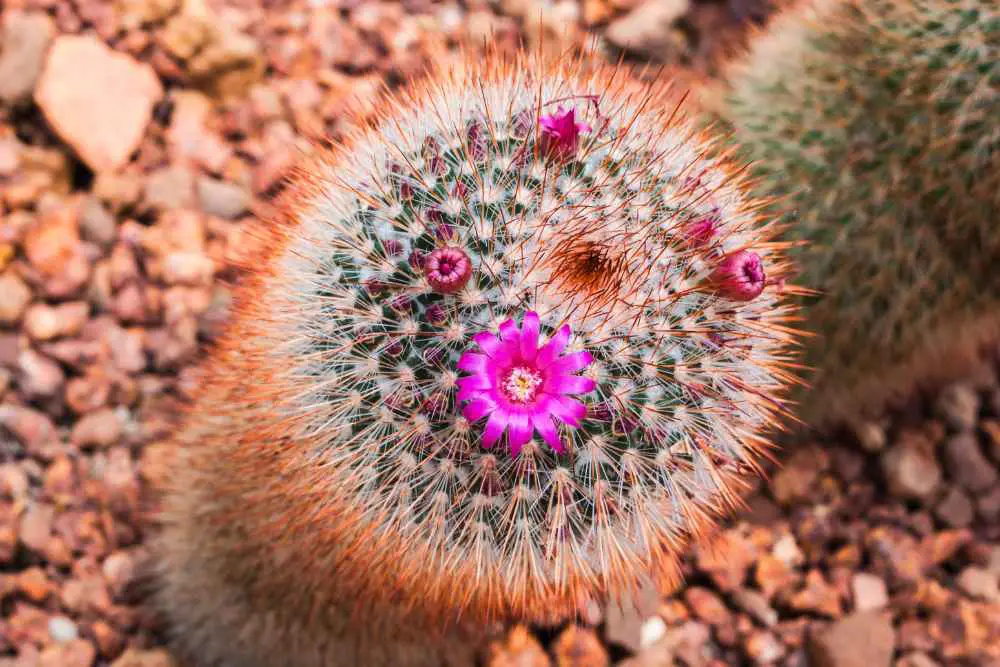
The phrase “pincushion cactus” is used to refer to the entire genus of cacti known as Mammillaria. There are currently 200 identified species of these cacti. When pincushion cacti bloom, they are capped with a circle of flowers, and their spines are small and often hairy in appearance. The majority of Mammillaria are indigenous to Mexico, although they can also be found in other hot, tropical regions, including the Caribbean and a few South American nations.
These cactus are just about 6 inches tall. Pincushion cacti do not have any issues with direct sunshine. They thrive in sandy soils that are grippy and have good drainage. While caring for a pincushion cactus, avoid using soil that holds too much water. You can water them once per week or twice per month.
4. Old Lady Cactus
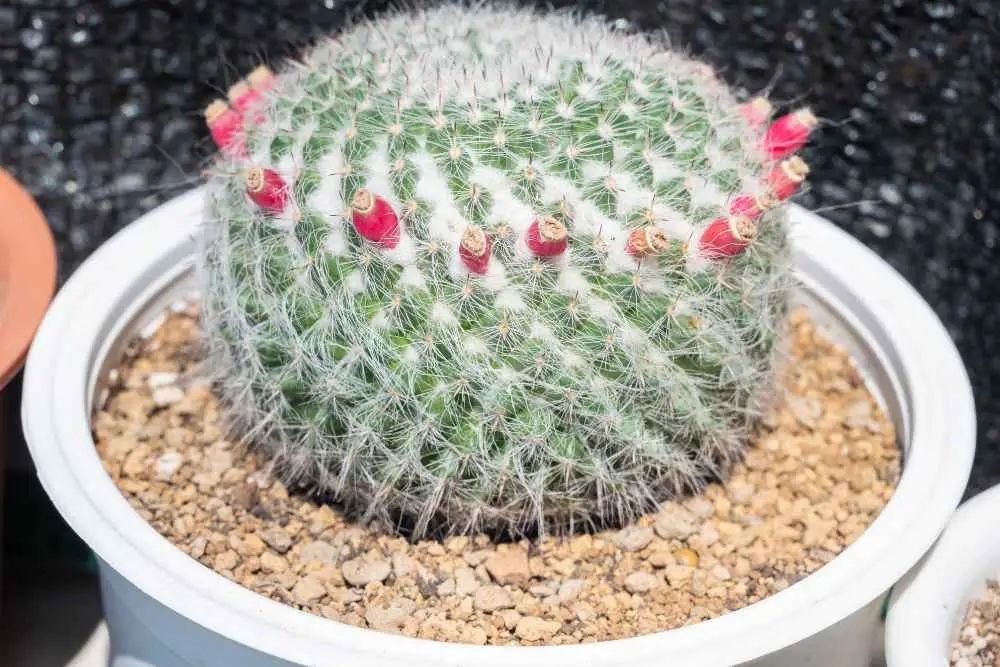
Mammillaria hahniana, or Old Lady Cactus, is a powder puff plant that grows in desert environments. It is indigenous to central Mexico. It can reach a height of 10 inches/25cm and a width of 20 inches/50cm. The width measures 12cm. Healthy plants may have a crown-like halo of pink blooms surrounding them. It is frequently protected by white spines. In addition to being common in arid regions, it also grows beautifully inside.
Just be sure to keep it away from overwatering and set it in the room’s brightest, sunniest area. A window facing south is ideal. It blooms in the spring and summer, producing red or purple flowers approximately 0.6 inch/15mm in diameter. It needs 4-6 hours of sunlight per day to grow.
Water only when the soil is nearly dry. Depending on the needs, it could be weekly or biweekly. Watering should be avoided during the winter unless the plant requires it. Use the offsets that frequently form clusters at the main plant’s base if you want to propagate. It will develop a callous if you remove the offset and let it dry for a few days. You can plant it in a new pot once it has formed.
5. Christmas Cactus
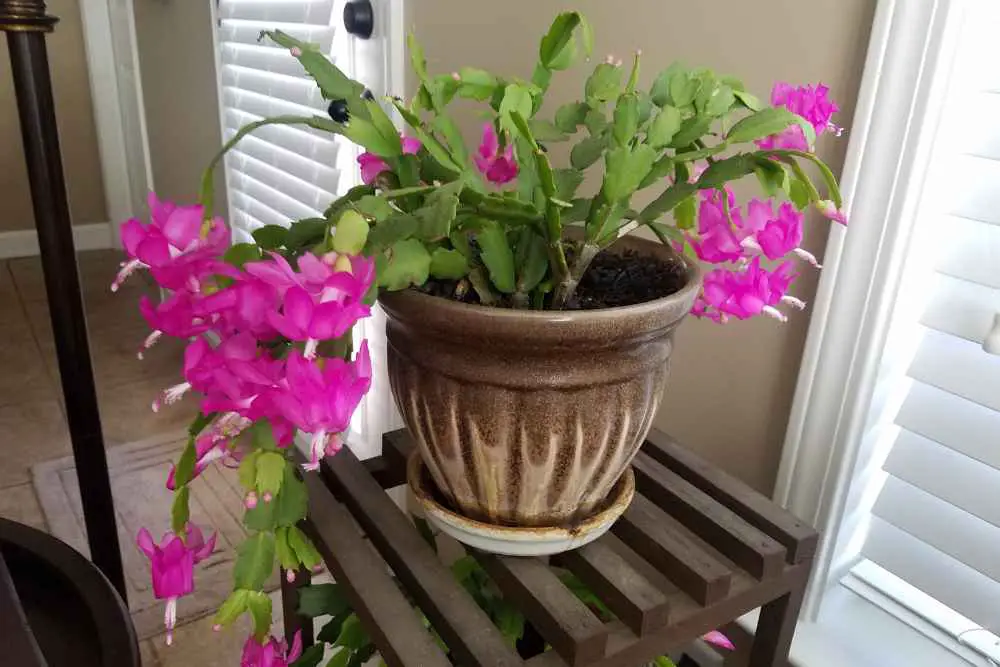
Schlumbergera bridgessii, popularly known as the Christmas Cactus Schlumbergera, is another nice little plant. This cactus is native to coastal Brazil and prefers a humid climate. A lot of people mistake this succulent for the Easter Cactus or the Thanksgiving Cactus. The Christmas cactus gets its name because it blooms throughout the holiday season. Flowers are typically pink, red, yellow, lilac, or white.
They are typically 3 inches in length. You can notice the growing leaf tips if you take good care of your plants. The tips will then start to darken until buds start to develop. The buds will then open to gorgeous flowers that are appropriate for the season around Christmas time.
The plant can be propagated by cuttings and thrives well indoors. Propagation should be done 2-3 months after blossoming. But, during the growth season, it is important to maintain your plant moist and water lightly as fall approaches to produce stunning blossoms. When it is flowering, it demands more water.
They thrive in natural light but should be kept out of direct sunlight to encourage blooming. Every 3-4 weeks, water them. only add water when your pot is dry. The Christmas cactus can be grown in a well-draining mix that is non-toxic to humans and pets. The soil you choose should have leaf litter and trash in it because that is what they feed on. And also the best part is this plant has no spines.
6. Easter Cactus
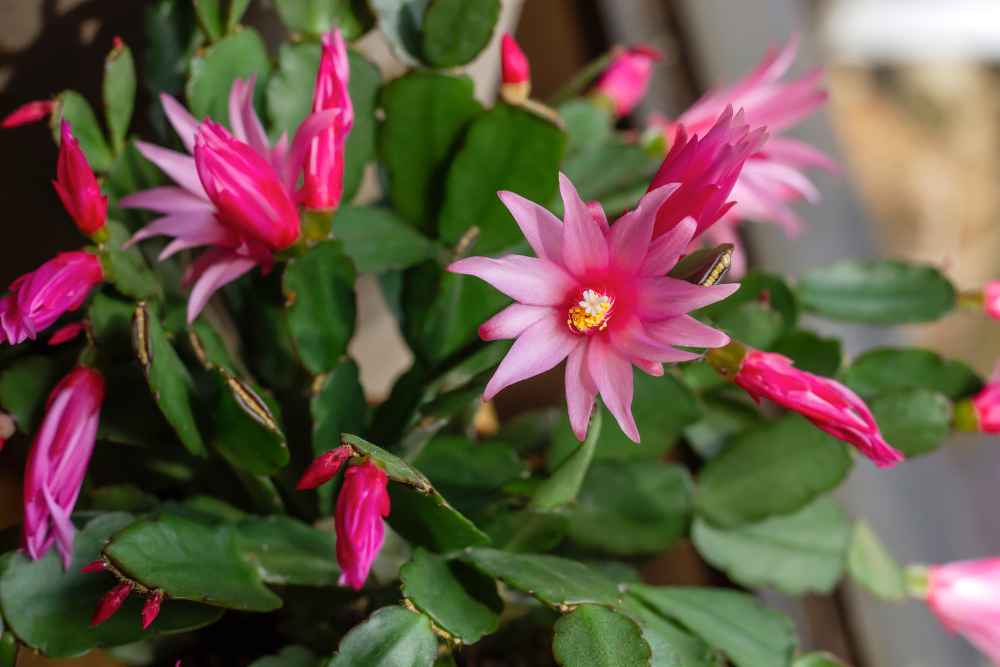
In the spring, the Easter cactus blooms are stunning. Hatiora gaertneri is the name of the plant, which is commonly confused with Christmas cactus plants. It makes an excellent indoor cactus and requires a humid but chilly environment to bloom annually.
Your plant, which develops in the rainforest rather than the desert like cacti, is more epiphytic and not a real cactus. However, it prefers sunny to partial light with moderate watering, just like the majority of succulent plants. The Easter cactus thrives in a potting mixture of soil and perlite that is safe for both people and animals.
7. Barrel Cactus
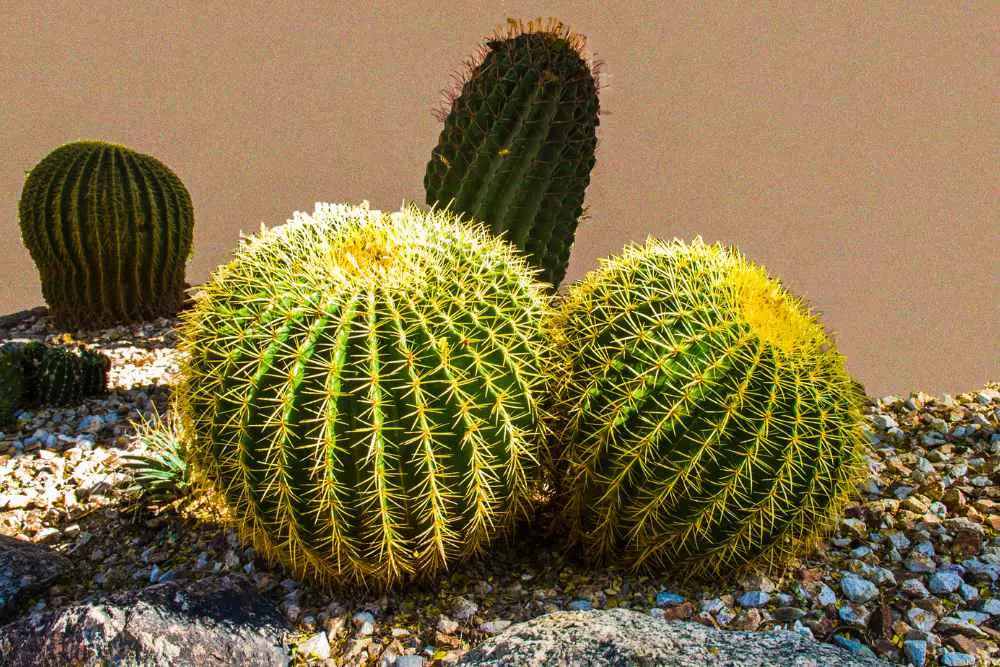
Barrel cacti are made up of several species from two genera: Ferocactus and Echinocactus. They are only found in southwestern North America. At maturity, some species can grow to be over 1 meter tall. Others have been recorded in some regions to reach 3 meters.
They are 30cm in width. Their average lifespan is about 100 years. Barrell cacti thrive under severe heat and direct sunlight, so it’s only natural to want to replicate those circumstances indoors. Muffin-shaped and frequently protruding over the rims of their pots, barrel cacti have a rounded appearance. The large fruits and wavy ribs of this plant make it simple to identify.
During the spring and summer, barrel cacti require full sunlight to blossom. April flowers are yellow, orange, or purple and can grow to reach up to 8cm across. Spines can grow to be up to 10cm long. When the cactus is quite mature, they form a circle shape on top of it. They are ideal indoors since you can control the amount of light they receive because direct sunlight can lead them to become stunted, burnt, and unable to develop.
Their low water needs result from their desert adaptations; you can even get away with watering them every two to three months. Unlike other varieties of cacti, barrel cacti are difficult to check for water because their shape almost completely hides the pot and it’s easy to get poked. Overwatering is the main cause of barrel cacti’s death. To prevent root rot, only water when you believe it to be necessary.
8. Bishop’s Cap
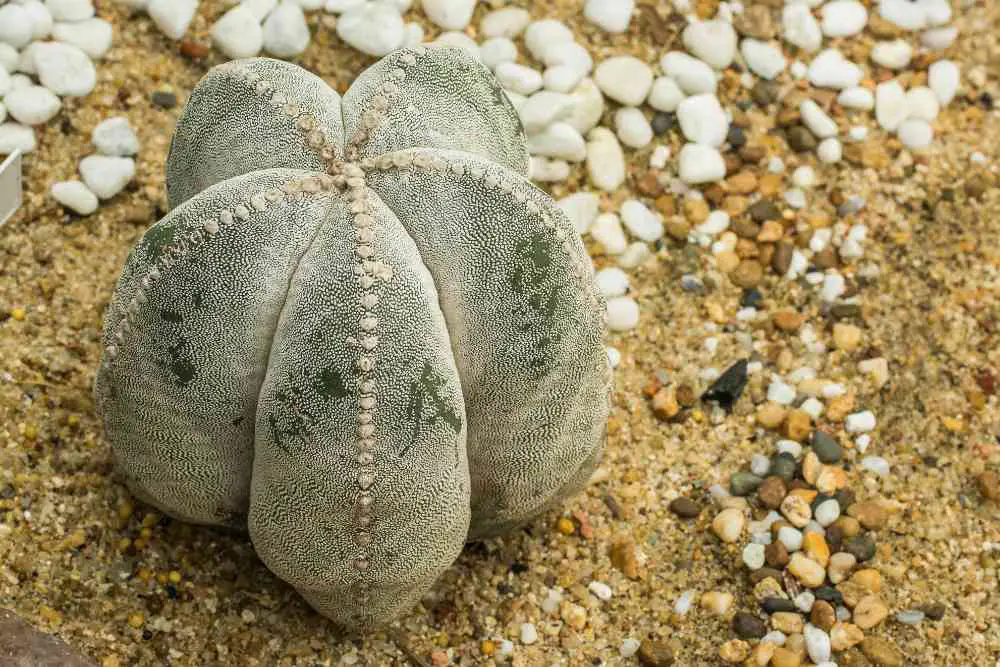
This specific type of cactus, sometimes known as bishop’s hat or bishop’s miter, is indigenous to the highlands of northeastern and central Mexico. Astrophytum myriostigma is its scientific name. Astrophytum, which means star plant in Greek.
While young, its star-like structure is defined by its three to seven vertical ribs on the outside. The number and shape of the ribs may change as the plant ages. The bishop’s cap reaches a height of 70–100 cm and a diameter of 10–20 cm. The typically daisy-like flower emerges from the cactus’ top. It normally has a maximum diameter of 2 inches.
Early April is when the cactus blossoms. It usually has one or more flowers that are creamy yellow with a crimson or orange foundation. Flowering can take up to six years. Every two days, one of its flowers blossoms.
Because immature plants cannot tolerate harsh light, the bishop’s hat is best grown inside. Never expose them to direct sunlight. Some sorts of cacti don’t require a lot of water. Watering should only be done frequently in the summer and not at all in the winter.
9. Peanut Cactus
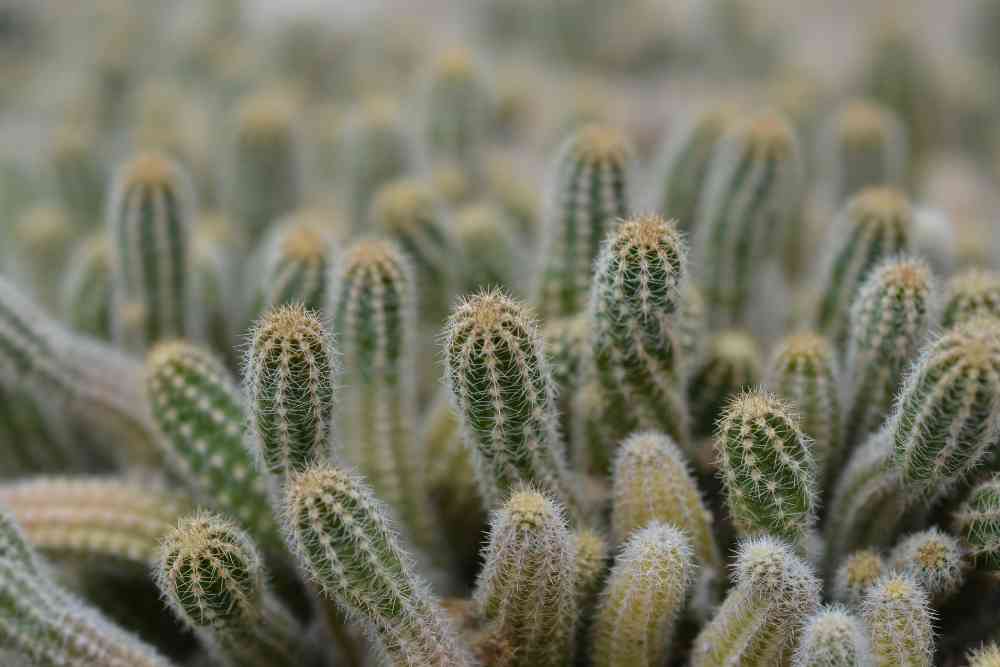
The Peanut Cactus gets its name from the clusters of finger-shaped stems it produces. Each stem can grow to be 6 inches long and 12 inches in diameter and is coated in small, white bristles. A peanut cactus can be cultivated both indoors and outdoors.
This cactus, scientifically known as Echinopsis chamaecereus, is native to Argentina. It has orange flowers that are 4cm/6 inches wide. The flowers bloom in late spring. They can reach a height of 15 cm/6 inches.
This cactus is very popular in hot-weather gardening and has a rapid growth rate. Arizona, Texas, and California are examples of these states. Peanut cacti are prone to rot and should only be watered when the top inches of soil is completely dry.
You can use a stick and dip it into the soil; if some moist soil remains on it, don’t water the plant. Also, because it enjoys warmer temperatures, provide it with as much sunlight as possible.
The bright sun from a south or west-facing window is preferred by these indoor cactus plants. Low lighting is not tolerated by the plant. Because of its thick, water-storing stems, the Peanut Cactus is a drought-tolerant indoor cactus.
Throughout the winter, limit watering to once a month at most. To grow this cactus house plant, use cactus or succulent soil, or supplement potting soil with coarse sand and perlite to promote drainage.
This indoor cactus can tolerate average household temperatures and humidity. It does not withstand high humidity and requires the use of a dehumidifier in humid situations. In the winter, provide temperatures ranging from 32 to 44 degrees Fahrenheit to replicate the cacti’s natural dormancy ( 0 to 7 degrees Celsius). Lower temperatures promote blossoming the next spring.
10. Sea Urchin Cactus
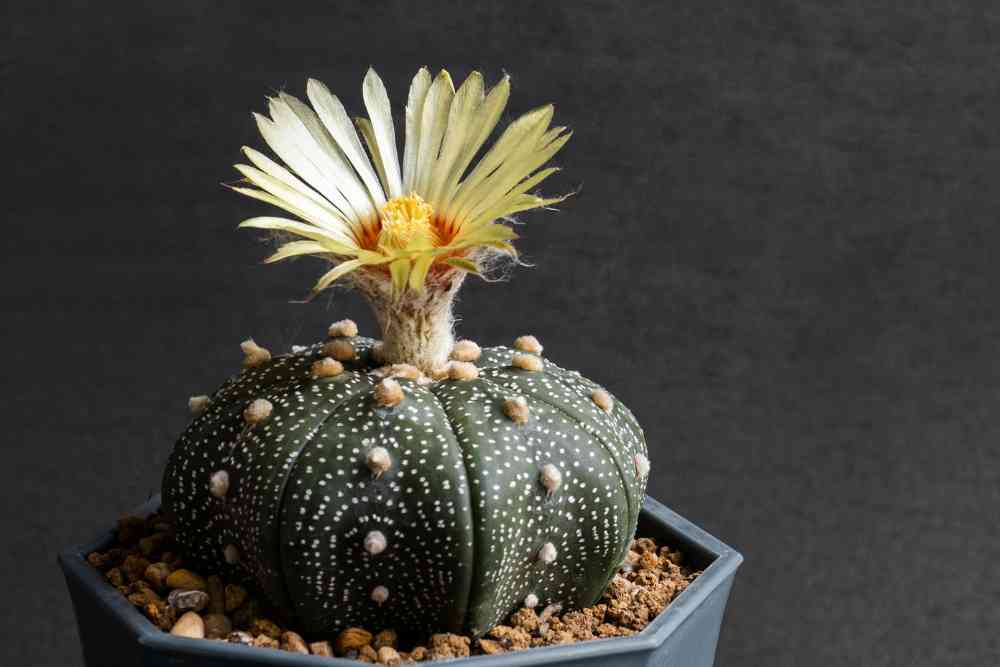
The sea urchin cactus (Echinopsis ancistrophora) is native to Bolivia and Argentina. This cactus is often regarded as the greatest small cactus plant to grow indoors by many gardeners. The plant develops from a tiny sphere that clusters into a big mass. The cactus has yellow radial spines that resemble spider legs and grow swiftly when flowering. When in bloom, it produces huge orange blooms as well as white flowers.
11. Rat Tail Cactus
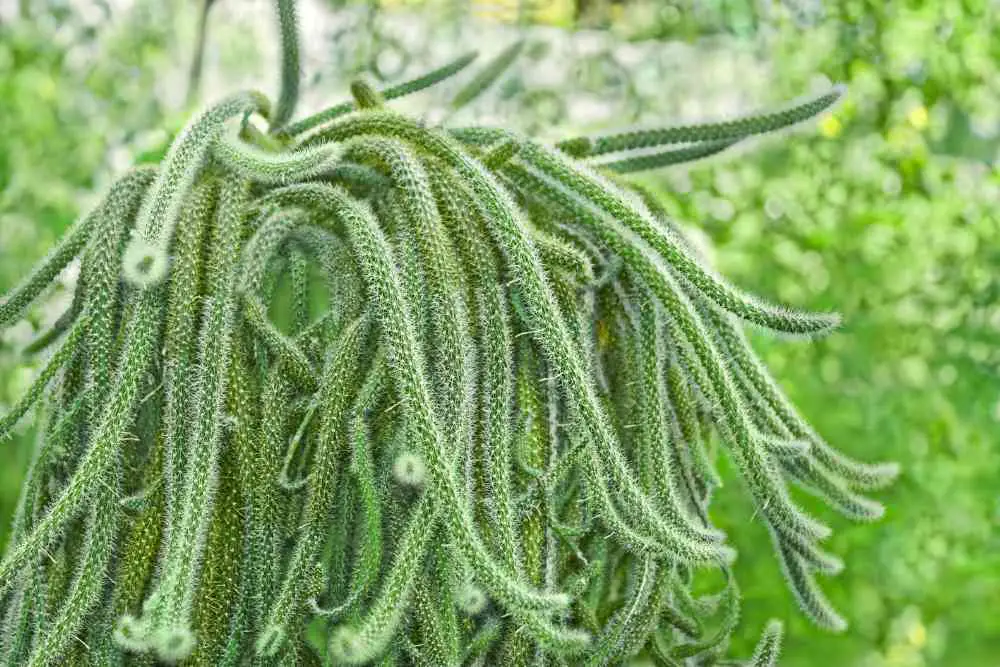
The Aporocactus flagelliformis or Disocactus flagelliformis is a Mexican native. It can be cultivated both indoors and outdoors, as well as in greenhouses. It is a very unusual plant with long, trailing stems that branch out and are between 8 and 24 mm thick and roughly 1-2 m long. Cactus flowers throughout the spring and summer and are usually red, violet, pink, or orange. The blossoms are typically 2 inches in diameter and remain for a few days.
Rat tail cacti are cultivated in hanging pots because of their trailing stems. Because the stems grow so quickly, it’s simple to reproduce by cuttings. Select a large hanging basket for this fast-growing cactus. This species requires direct sunlight. Place your plant or container near or on a south or west-facing window.
When the cactus is blooming in the summer, keep the potting soil moist. However, water carefully during the winter; when the soil is dry. During the summer, spring, and early autumn, your cactus is just good at room temperature. During the winter, though, keep the cactus in a more relaxed environment.
12. African Milk Tree
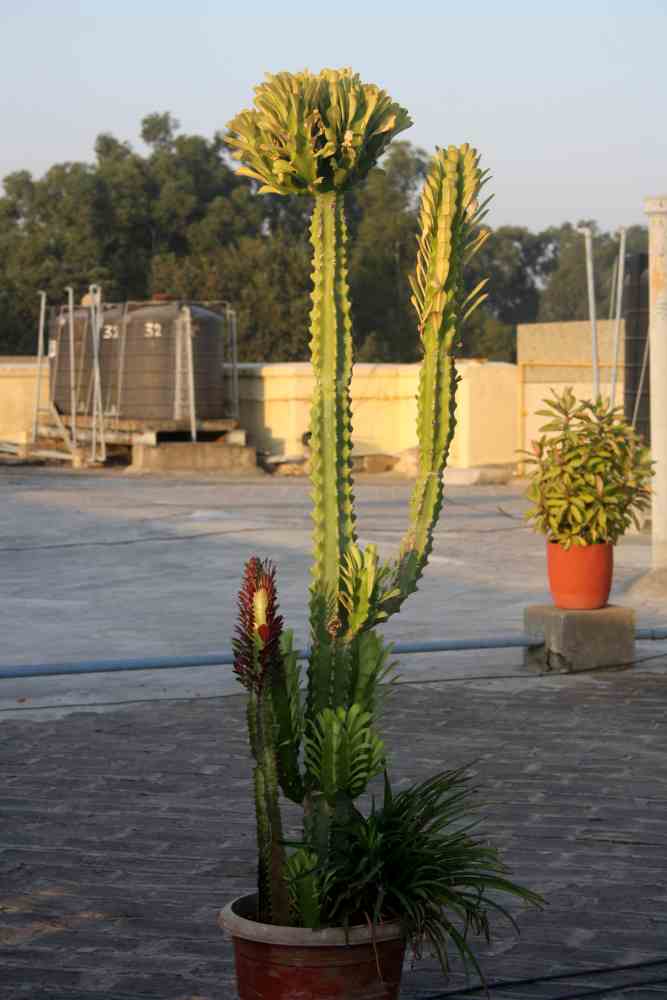
African Milk Tree’s (Euphorbia trigona) growth pattern resembles that of ordinary desert cacti, even though it is technically a succulent and not a cactus. It is utilized as an outdoor hedge in favorable conditions and grows quickly, at a rate of 1 to 2 feet (30 to 60 cm) each year. Each triangle stem has three unique sides, which are separated by high ridges. The stems have thorns and teardrop-shaped leaves that emerge.
It can reach a height of 9 feet (2.7 meters) when grown outdoors, but when planted indoors, growth is often cut in half. The plant prefers indirect light from a south-facing window that is bright and indirect.
Keep the soil moist but not wet. Let the soil dry between waterings, checking for moisture with an inserted stick. Throughout the fall and winter, limit watering to once a month. Cultivate this succulent in perlite-enriched potting soil with good drainage.
Use a water-soluble fertilizer that has been diluted to half its strength to fertilize once a month in the spring and summer. The plant enjoys temperatures over 55 degrees Fahrenheit (13 degrees Celsius), but not high humidity, which makes the plant prone to pests and disease.
13. Saguaro Cactus

This species, also known as Carnegiea gigantea, can reach heights of more than 40ft/12m. The Whipple Mountains, the Sonoran Desert in Arizona, Imperial County in California, and the Mexican state of Sonora are all home to the Saguaro. It can live for approximately 150 years. It blooms between April and June. The flowers bloom after sunset and fade by mid-afternoon.
Its fruits are red and range in size from 2.4 to 3.5 inches. They are edible and ripen in June. Saguaros are barrel-shaped plants with peripheral stems that serve as “arms.” The more water the plant holds, the more it expands and weighs as a result. A Saguaro foot can weigh up to 90 pounds. A grown one can even weigh a ton or more.
Watering cacti is an important part of the plant because adequate care is required for it to develop properly. Every 10 to 14 days, water the Saguaro. To avoid root rot, check to see if the soil still contains moisture before watering it.
14. Fishbone Cactus
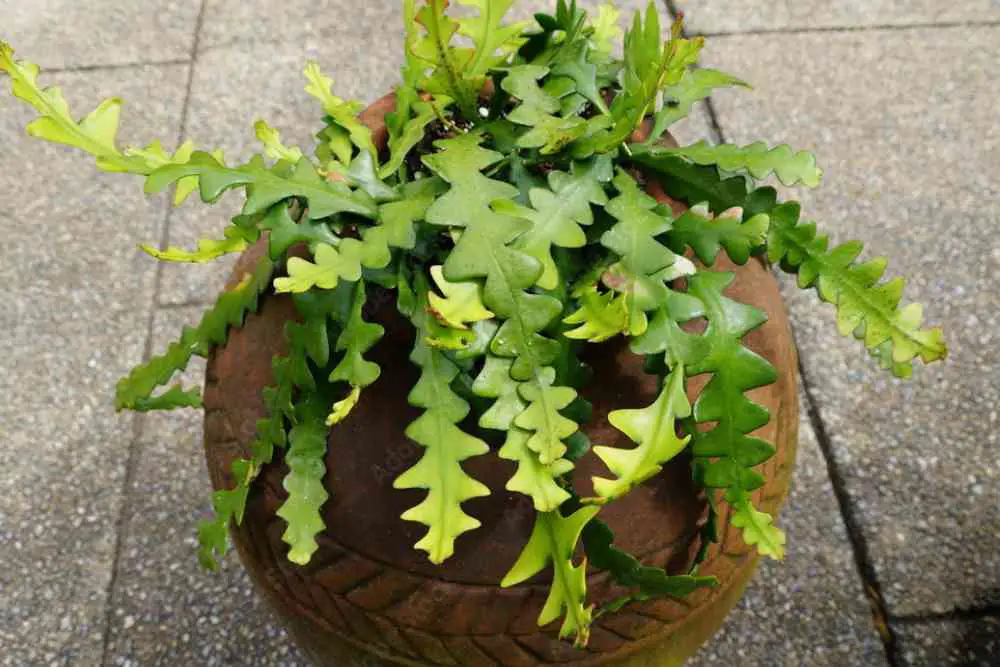
Fishbone cacti (Epiphyllum anguliger), so named because of their smooth, spineless stems that resemble fishbones rather than the flat, zigzag shapes that they resemble, are excellent selections for homes with young children or curious indoor animals. These cacti, like rattail cacti, thrive in hanging baskets. Fishbone cacti are native to Mexico and prefer indirect, moderate light. It is ideal to place these individuals in a south-facing window with indirect or medium-light exposure.
They should be watered sparingly. One advantage of the Fishbone Cactus is that it does not require a lot of water. these cacti can produce fragrant white or yellow blooms under the correct circumstances, but they only last a day or two, so make the most of them while you can. This Epiphyllum does develop flower buds throughout the appropriate seasons, and you do not need to provide additional food for it to do so.
The Fishbone Cactus, which grows tall in Mexico’s desert terrain, is a real eye-catcher. This species leaves zigzag rather than have spines like the majority of Cactaceae members do. They are also silky and will not sting you. They are usually around five inches long and six inches wide.
The Fishbone Cactus is somewhat particular about the type of soil it is planted in because it is not as hardy as its cactus siblings. Consider how much moisture you should add to this variety of cactus. Branches that turn yellow or off-white often indicate that the plant is unhappy with the current temperature. If you must handle a Fishbone Cactus, do it carefully since they are fairly fragile.
15. Sand Dollar Cactus / Star Cactus
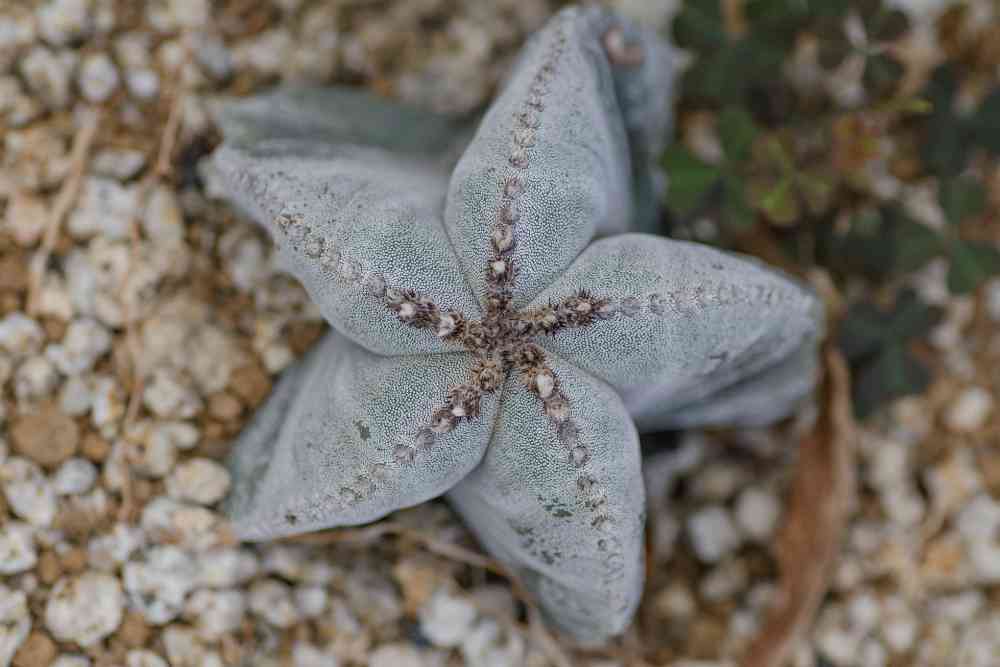
The star cactus (Astrophytum asteria) is the cutest thing ever. The sand dollar cactus resembles both a sand dollar and a star when viewed from above. It’s a friendly spineless cactus with a round fat body. The star cactus is simple to grow as an indoor plant. The 6-inch-wide, circular, chubby body has ridged sides and a white dot pattern covering them. When grown properly, indoor cacti produce yellow blooms with orange centers between March and May.
In late spring, as the blossoms fade, berries take their place. It requires full light and occasional watering when grown inside in a sandy potting mix. Because the cactus stores a lot of water, it’s important to avoid overwatering, which can cause root rot. It is also a non-poisonous cactus for humans and pets.
The easiest way to care for this starfish-shaped cactus is to add water as needed. Even when provided with relatively small amounts of water, they are quite amenable. A standard soil mix should be sufficient for this cactus.
The Star Cactus does not require fertilizer to survive. If you want to start making new plants from old ones, then seedlings are the way to go. Happily, this is among the simplest approaches to accomplishing it. The Star Cactus has a relatively average temperature request and can survive lower temperatures when compared to other Cactaceae species.
16. The Blue Hens and Chicks
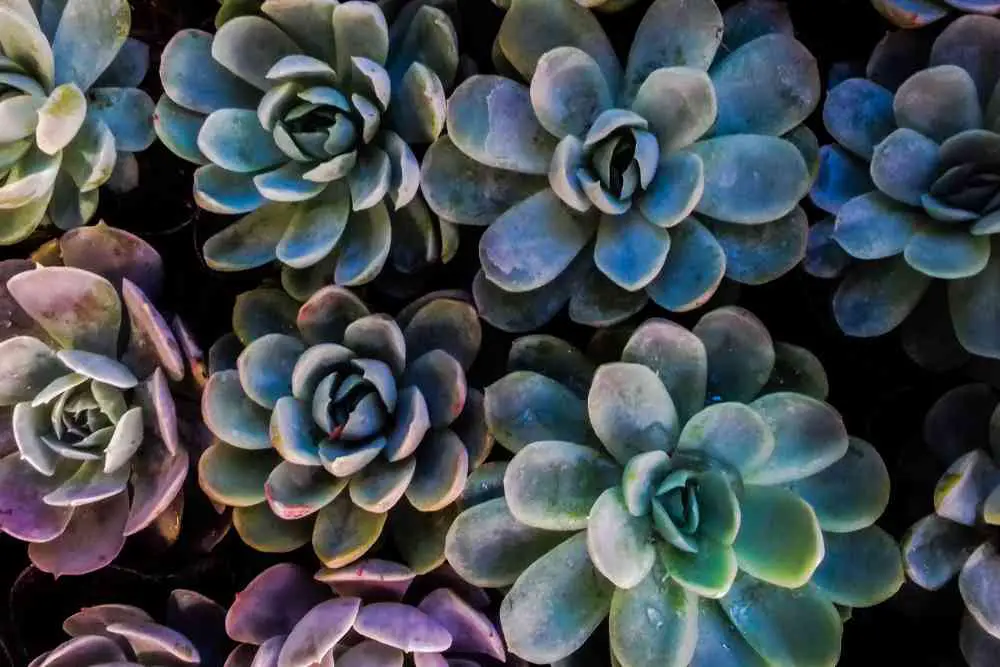
Members of the Crassulaceae family are native to Mexico, South America, and Central America’s semi-desert regions. The Latin word “glauca” means “blue” if you were to decipher the scientific name. Its term is appropriate because the blue rosette is made up of several clusters. Within each of these colonies, there are hundreds of plants. This species resembles a leathery desert rose in appearance. One advantage of owning a Blue Hen Cactus is that it is drought tolerant.
This cactus species can withstand higher temperatures than usual, making it excellent for indoor environments.
This Echeveria is ideal for those looking for a small plant to set on a sunny windowsill. Leaf cuttings make it simple to create a new individual from an old one. Applying food is not necessary or advised, even throughout the growing season. The bottom half of these plants quickly become infested with dead leaves, which must be removed to prevent pest infestation. Shriveling, wilting, or leaf dropping are all symptoms of a bad watering schedule that has to be adjusted.
17. Desert Candle
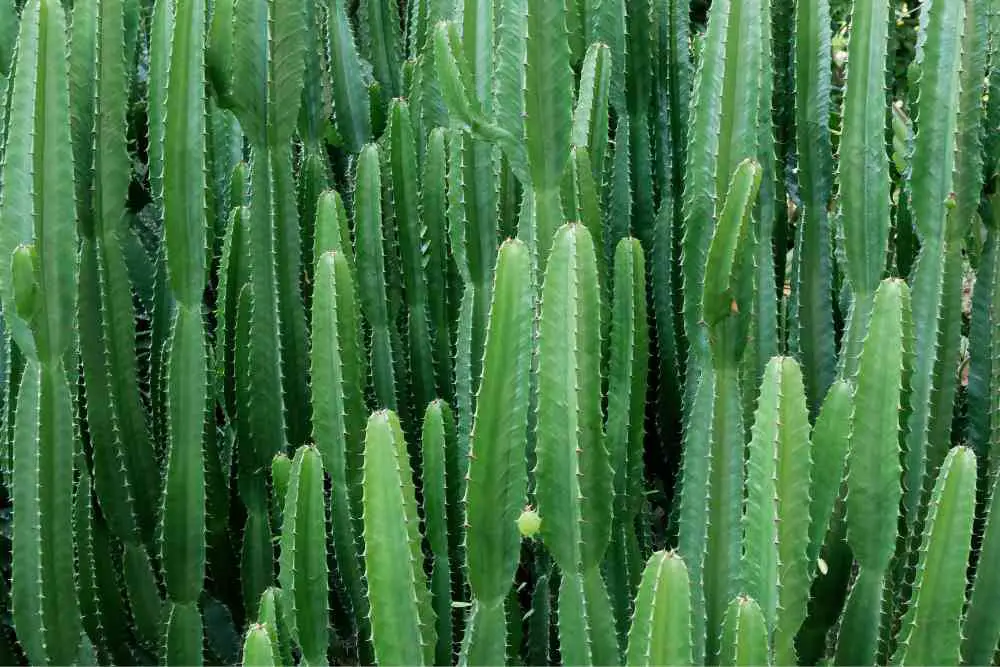
The Desert Candle Cactus (Euphorbia Acrurensis) is a distinctive addition to your indoor plants because it is native only to South and West Africa. Similar to a typical cactus, these plants have ribbed, slender stalks that extend upward into the sky.
The distinction is in the leaves, which are tiny, oval, and sticking out at a perpendicular angle from the stems. Even when grown inside, this Euphorbia can grow to be five to eight feet tall. Certain plants require careful planning for the proper pH levels.
Not with this cactus. When it comes to the soil, they’re relatively easygoing. When it comes to these plants, fertilizer should be used sparingly. You can skip giving your Desert Candle any at all if you’re unclear about when or how much to add. Choose a windowsill that receives plenty of bright, indirect sunlight and observes how this plant bends toward the sun.
This Euphorbia prefers infrequent watering, which makes your job much easier. You may detect if your watering plan needs to be adjusted by observing how quickly the leaves are shriveling up. Root rot is common in people who do not provide adequate soil and drainage for their Desert Candle. The room temperature should be comfortable for your Desert Candle as long as there are no chilly drafts.
- 15 Ingenious Kitchen Garden Ideas to Cultivate Freshness Right at Home - April 7, 2024
- 10 Top Picks Best Plants for Open Terrarium - April 2, 2024
- 21 Easy and Cheap Walkway Ideas for a Charming Garden - March 31, 2024

